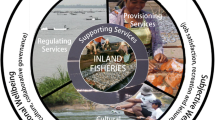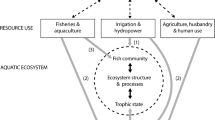Abstract
The Sundarbans represent the largest remaining tract of coastal mangrove wetlands in tropical Asia. The dynamics of the fish communities are poorly understood, and current research indicates a fragile ecology. Various development projects have had serious negative impacts on the estuarine fishes in nearby parts of Bangladesh. Impacts on the fisheries tend to affect the poorest elements of the society, the landless subsistence fishermen. The record of development assistance agencies is poor, with respect to the environment in general and fisheries in particular. Taking steps to rectify the problem would include environmental review of projects prior to and during project implementation. Given the lack of a pure research base in the tropics, applied research is often modeled on temperate systems, which can be disastrous. Thus, it is also suggested that basic research on the environment be supported in order to build an understanding of tropical ecosystems prior to any attempts at manipulation of these ecosystems.
Similar content being viewed by others
References
Abrams, P. A. 1984. “Foraging time optimization and interactions in food webs.”American Naturalist 124:80–96.
Bailey, C. 1988. “The political economy of fisheries development in the third world.”Agriculture and Human Values 5(1–2):35–48.
Balon, E. K. 1974. “Fish production of a tropical ecosystem.” In, Balon, E. K. and A. G. Coche, (eds.) “Lake Kariba, a Man-made Tropical Ecosystem in Central Africa.”Monographiae Biologicae 24(2):253–676.
Balon, E. K. 1975. “Reproductive guilds of fishes: a proposal and definition.”Journal of the Fisheries Research Board of Canada 32:821–864.
Balon, E. K. 1983. “Patterns of evolution of reproductive styles in fishes.” In, Potts, C. W. and R. J. Wootton, (eds.)Fish reproduction: strategies and tactics. p. 35–53. Academic Press, London.
Beamish, F. W. H. 1964. “Respiration of fishes with special emphasis on standard oxygen consumption. II. Influence of weight and temperature on respiration of several species.”Canadian Journal of Zoology 42:177–188.
Bishop, J. E. 1973. “Limnology of a small Malayan river, Sungai Gombak.”Monographiae Biologicae 22:1–485.
Chowdhury, A. Q. and K. F. Lagler. (eds.) 1978. “Fishery development in irrigation and flood control systems.” First Annual Report for: Irrigation-Fishery Development Project for Chandpur, Muhuri, and Karnafuli, People's Republic of Bangladesh.
Dungan, M. L. 1987. “Indirect mutualism: complementary effects of grazing and predation in a rocky intertidal community.” In, Kerfoot W. C. and A. Sih. (eds.)Predation: direct and indirect impacts on aquatic communities. p. 188–200. University Press of New England, Hanover.
Goulding, M. 1981. “Man and fisheries on an Amazon frontier.”Developments in Hydrobiology 4. Dr. W. Junk, The Hague.
Herring, Ronald J. 1990. “Rethinking the Commons,”Agriculture and Human Values, Vol VII, No. 2:88–104.
Jhingran, V. G. 1977.Fish and Fisheries of India. Hindustan Publishing, Delhi.
Kerfoot, W. C. and A. Sih. 1987.Predation: direct and indirect impacts on aquatic communities. University Press of New England, Hanover.
Lagler, K. F. 1976.Fisheries and integrated Mekong River Basin development. Terminal report of the Mekong Basinwide Fishery Studies. Committee or Coordination of Investigations of the Lower Mekong Basin UN/ESCAP, University of Michigan School of Natural Resources. 3 vols. variously paged.
Lagler, K. F. 1982. “Integrating fishery resource allocation into tropical river basin development and water management schemes.” In, Grover, J. G. (ed.)Allocation of Fishery Resources. Proceedings of the technical consultation on allocation of fishery resources held in Vichy, France, 20–23 April 1980. Published by The Food and Agriculture Organization of the United Nations and the American Fisheries Society. p. 180–190.
Lowe-McConnell, R. H. 1975.Fish communities in tropical freshwaters, their distribution, ecology and evolution. Longman, London.
Lowe-McConnell, R. H. 1987.Ecological studies in tropical fish communities. University Press, Cambridge.
Margalef, R. 1969. “Diversity, stability, and productivity.” In: Woodwell, G. M.and H. H. Smith (eds.)Diversity and stability in ecological systems. Brookhaven Symposium in Biology 22:25–27.
May, R. M. 1974.Stability and complexity in model ecosystems. Princeton University Press, Princeton, NJ.
May, R. M., Beddington, J. R., Clark, C. W., Holt, S. J. and R. M. Laws. 1979. “Management of multispecies fisheries.”Science 205:267–277.
Mekong Committee. 1982. “Nam Pong Environmental Management Research Project. Final report for phase III. Part I. An integrated simulation model for resource management.” Mekong Committee, Bangkok.
Oag, T. M. 1939. “Report on the River Hooghly and its headwaters.” Commissioner for the port of Calcutta. Calcutta, India.
Paine, R. T. 1974. “Intertidal community structure: experimental studies on the relationship between a dominant competitor and its principal predator.”Oecologia 15:93–120.
Pauly, D. 1983. “Some simple methods for the assessment of tropical fish stocks.”FAO Fisheries Technical Papers 234:1–52.
Pillay, T. V. R. 1967. “Estuarine fisheries of the Indian Ocean Coastal Zone.” In, Lauff, G. H. (ed.)Estuaries. Publications of the American Association for the Advancement of Science 83:647–657.
Rainboth, W. J. 1978. “The fish and prawn stocks of the Muhuri Irrigation Project and the surrounding region, with special reference to the potential impacts of the Feni River crossdam and regulator on the fish and fisheries.”Government of Bangladesh/Irrigation Fishery Development Project Working Document 17:1–58.
Rainboth, W. J. 1990. “The fish communities and fisheries of the Sunderbans, with a framework for future studies.” In,The Commons of Southeast Asia: Societal Pressures and Environmental Integrity in the Sunderbans of Bangladesh. Proceedings of the 1987 Smithsonian Workshop on the Commons in Asia, using the Sunderbans as a Case Study. (in press)
Regier, H. A. and H. F. Henderson. 1973. “Towards a broad ecological model of fish communities and fisheries.”Transactions of the American Fisheries Society 102:56–72.
Rosenberg, D. M. and V. H. Reshet al. 1981. “Recent trends in environmental impact assessment.”Canadian Journal of Fisheries and Aquatic Sciences 38:591–624.
Ryder, R. A. 1982. “The morphoedaphic index—use, abuse, and fundamental concepts.”Transactions of the American Fisheries Society 111:154–164.
Ryder, R. A., Kerr, S. R., Loftus, K. H. and H. A. Regier. 1974. “The morphoedaphic index, a fish yield estimator—review and evaluation.”Journal of the Fisheries Research Board of Canada 31:663–688.
Tiews, K., Sucondhamarn, P. and A. Isarankura. 1967. “On the changes in the abundance of demersal fish stocks in the Gulf of Thailand from 1963/1964 to 1966 as consequence of the trawl fisheries development.”Publications of th Marine Fisheries Laboratory, Bangkok 8:1–39.
Vannote, R. L., Minshall, G. W., Cummins, K. W., Sedell, J. R. and C. E. Cushing, 1980. “The river continuum concept.”Canadian Journal of Fisheries and Aquatic Sciences 37(1):130–137.
Watson, D. J. 1982. “Subsistence fish exploitation and implications for management in the Baram River system, Sarawak, Malaysia.”Fisheries Research 1:299–310.
Watson, D. J. and E. K. Balon, 1984. “Structure and production of fish communities in tropical rain forest streams of northern Borneo.”Canadian Journal of Zoology 62:927–940.
Welcomme, R. L. 1979.Fisheries ecology and floodplain rivers. Longman Group, New York.
Additional information
1. I would like to dedicate this work to the memory of the late Professor Karl F. Lagler, who introduced me to Asiatic fishery work in the Mekong River during the middle 1970's and in Bangladesh during the late 1970's. Much of what I saw and learned in those projects has aided me in more recent studies and will serve as a source for ideas for years to come. Preparation of this paper was supported in part by National Science Foundation grant BSR85-16738 to Walter J. Rainboth and Donald G. Buth. I thank Professor Don Buth for reading and commenting on the manuscript.
Rainboth is a research scientist in the Department of Biology at UCLA. He is a fish specialist with Species Survival Commission of the International Union for the Conservation of Nature. During the last 15 years, he has conducted faunal surveys and stock assessment for development projects in the Mekong River of Southeast Asia, the Gangetic river system of Bangladesh, and the Gambia River of West Africa. His research interests include quantitative systematics and faunistics as well as the seasonal dynamics of fish communities in floodplain ecosystems.
Rights and permissions
About this article
Cite this article
Rainboth, W.J. The fish communities and fisheries of the Sundarbans: Development assistance and dilemmas of the aquatic commons. Agric Hum Values 7, 61–72 (1990). https://doi.org/10.1007/BF01530437
Issue Date:
DOI: https://doi.org/10.1007/BF01530437




